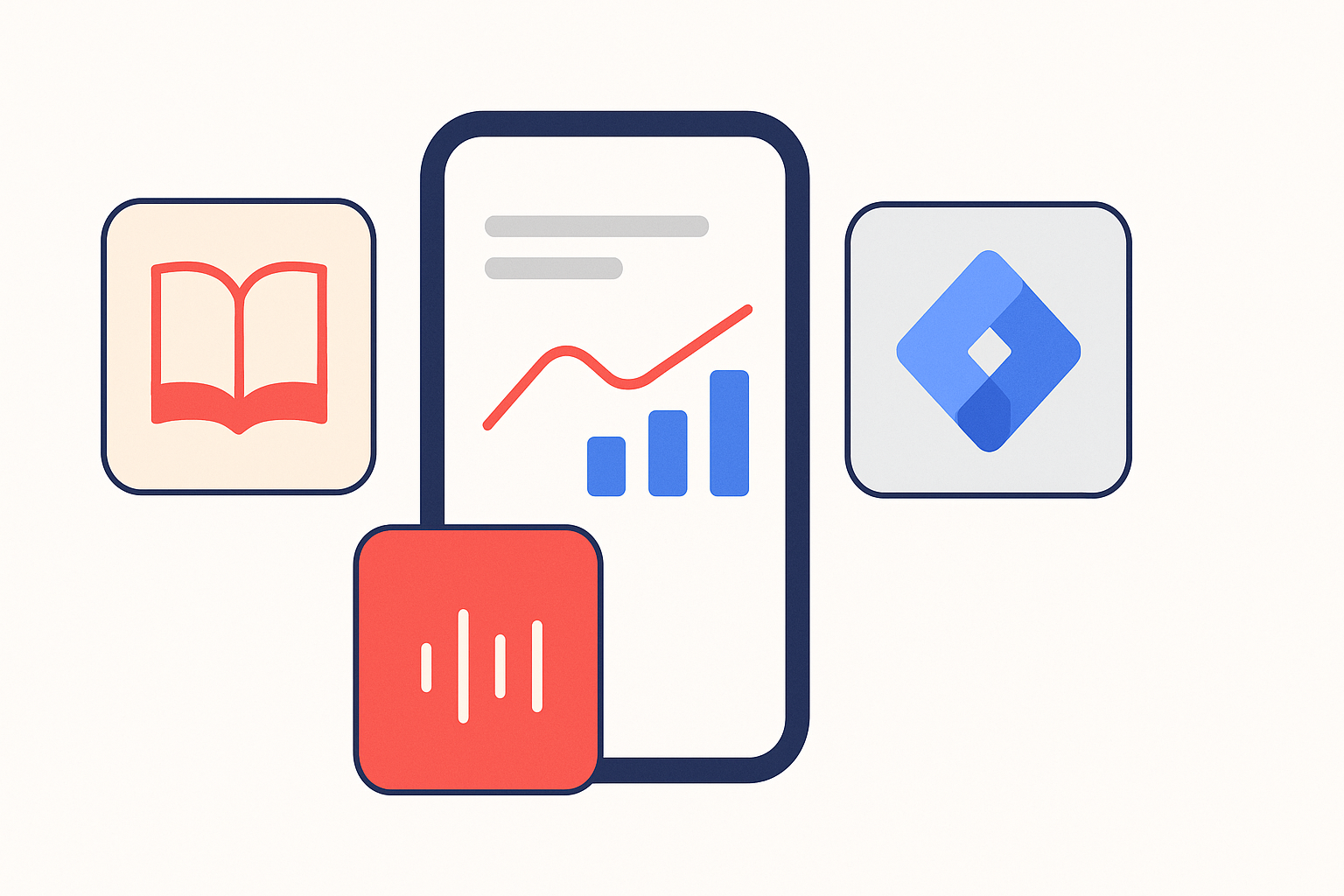Google Tag Manager setup with Audiorista

Google Tag Manager (GTM) makes it easier to track marketing and analytics events without coding, but on its own it doesn’t solve distribution, monetization, or branding needs for creators. By combining GTM with Audiorista’s Business plan, you not only simplify tracking and app analytics integration but also unlock no-code app creation, white-label branding, monetization tools, and direct audience ownership—turning analytics into actionable growth opportunities.
Understanding Google Tag Manager setup
Google Tag Manager simplifies event tracking and analytics management by allowing marketers and publishers to deploy tracking tags, conversion pixels, and analytics codes without constant developer input. This makes managing marketing technology stacks more efficient and responsive. However, while GTM streamlines technical tag execution, challenges often arise with initial setup complexity, app integrations, and fully leveraging the data collected. For example, without development support, configuration can be slower, and integrating into branded environments like apps is not always straightforward. Audiorista removes these layers of complexity by offering a no-code integration with Google Tag Manager directly within its Business plan. This makes it possible to set up granular event tracking in white-labeled apps with ease, ensuring insights are both simple to capture and actionable for business growth.
Google Tag Manager vs Google Analytics
Google Tag Manager and Google Analytics are often mentioned together, but they fulfill different roles. Tag Manager acts as the deployment tool, allowing marketers to add, update, and manage analytics and marketing tags without modifying underlying codebases. Analytics, by contrast, is where the actual performance data is processed and presented, showing what users are doing across your platforms. Working together, they create a full feedback loop: GTM deploys the measurement framework, and Analytics interprets it into insights. By adding Audiorista into the mix, publishers go a step further—those measurable insights can now translate directly into monetization and audience engagement within branded apps. Simplified:
- GTM = tag deployment
- Analytics = performance data
- Audiorista = monetization + branded app growth layer
Best practices for Google Tag Manager in apps
GTM implementation in apps requires strategic structure to ensure long-term scalability. Best practices include establishing clear naming conventions for tags, maintaining logical event categorization, and ensuring data consistency across platforms. Adhering to these rules creates a reporting structure that’s easier to analyze and act upon. Yet, for many publishers, embedding GTM within a branded app remains difficult without technical resources. Audiorista addresses this by enabling users to integrate GTM into their no-code, white-label apps in minutes, ensuring even non-developers can adhere to best practices without implementation bottlenecks. Additionally, by combining GTM data with Audiorista’s app environment, publishers can unlock benefits of integrated mobile payment systems, such as streamlined payment flows and enhanced conversion opportunities. More details on this can be found in Audiorista’s guide to the benefits of integrated mobile payment systems.
How to use Google Tag Manager with Audiorista
Using GTM within Audiorista-powered apps is straightforward on the Business plan. After setting up your GTM container, it can be integrated directly into Audiorista’s branded app environment. From there, creators can track event-specific data throughout their applications, including engagement metrics, subscription conversions, and content performance signals. This direct connection ensures publishers can continue leveraging their analytics workflows but without the manual development overhead. The deep integration provides a reliable way for creators to understand user journeys and behaviors, while simultaneously having the infrastructure in place to act on that data through monetization tools and audience engagement features embedded within the Audiorista platform.
Turning analytics into growth opportunities
While GTM provides clarity about what is happening in user interactions, it doesn’t provide the mechanism to take the next step toward revenue or engagement growth on its own. Audiorista builds that bridge. With GTM data powering audience insights, publishers can immediately monetize based on behaviors, sending push notifications at relevant moments, driving personalized campaigns, or adjusting content strategies for stronger retention. Specific examples include tailoring subscription offers to behavior-tagged audiences, sending notifications based on completed in-app events, and refining content catalogs by responding to GTM-tracked engagement levels. These operational steps transform analytics into growth channels that directly increase revenue opportunities. For further guidance, Audiorista also provides insights into SEO and content growth strategies that complement GTM data to drive long-term business results.
Complete extension for creators
The true benefit for creators lies in extending GTM beyond data collection. When paired with Audiorista, GTM becomes part of a larger system that empowers creators to act effectively. By combining precise analytics tracking with the full toolkit of audience ownership, no-code deployment, branding flexibility, and varied monetization pathways, Audiorista offers a complete extension to the limited functions of GTM alone. This synergy ensures GTM insights aren’t just reports but pathways to actionable strategies inside environments publishers directly control. With GTM data feeding Audiorista’s apps, publishers can confidently scale with both insight and impact, closing the gap between knowing how audiences behave and being able to capitalize on those behaviors through effective monetization and branding execution.
Conclusion
Google Tag Manager simplifies analytics deployment and event tracking, but its utility is focused on measurement rather than action. The challenges often come from implementation complexity and the limits of GTM when it comes to app integration, monetization, and branding. Audiorista resolves these challenges by offering seamless, no-code integration with GTM inside white-labeled apps. Compared with Google Analytics, which provides insights, and GTM, which manages tags, Audiorista provides the growth layer where data becomes actionable through monetization and engagement tools. Best practices that may otherwise require development teams—like structured event tracking in apps—become fast and manageable within Audiorista’s Business plan. Most critically, the partnership between GTM and Audiorista turns analytics from passive reporting into active business growth strategies through direct monetization, tailored engagement, and branded experiences. Keep using Google Tag Manager for powerful analytics, but scale further by pairing it with Audiorista’s Business plan—where you can monetize, design branded apps, and fully own your audience without sacrificing the tools you already trust.


